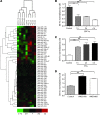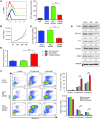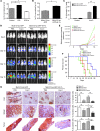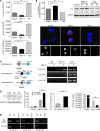CXCR4 downregulation of let-7a drives chemoresistance in acute myeloid leukemia
- PMID: 23676502
- PMCID: PMC3668829
- DOI: 10.1172/JCI66553
CXCR4 downregulation of let-7a drives chemoresistance in acute myeloid leukemia
Abstract
We examined the role of microRNAs (miRNAs) in targeting the stromal-derived factor 1α/CXCR4 (SDF-1α/CXCR4) axis to overcome chemoresistance of AML cells. Microarray analysis of OCI-AML3 cells revealed that the miRNA let-7a was downregulated by SDF-1α-mediated CXCR4 activation and increased by CXCR4 inhibition. Overexpression of let-7a in AML cell lines was associated with decreased c-Myc and BCL-XL protein expression and enhanced chemosensitivity, both in vitro and in vivo. We identified the transcription factor Yin Yang 1 (YY1) as a link between SDF-1α/CXCR4 signaling and let-7a, as YY1 was upregulated by SDF-1α and downregulated by treatment with a CXCR4 antagonist. ChIP assay confirmed the binding of YY1 to unprocessed let-7a DNA fragments, and treatment with YY1 shRNA increased let-7a expression. In primary human AML samples, high CXCR4 expression was associated with low let-7a levels. Xenografts of primary human AML cells engineered to overexpress let-7a exhibited enhanced sensitivity to cytarabine, resulting in greatly extended survival of immunodeficient mice. Based on these data, we propose that CXCR4 induces chemoresistance by downregulating let-7a to promote YY1-mediated transcriptional activation of MYC and BCLXL in AML cells.
Figures







Similar articles
-
Antileukemia activity of the novel peptidic CXCR4 antagonist LY2510924 as monotherapy and in combination with chemotherapy.Blood. 2015 Jul 9;126(2):222-32. doi: 10.1182/blood-2015-02-628677. Epub 2015 Jun 1. Blood. 2015. PMID: 26031918 Free PMC article.
-
CXCR4-mediated signaling regulates autophagy and influences acute myeloid leukemia cell survival and drug resistance.Cancer Lett. 2018 Jul 1;425:1-12. doi: 10.1016/j.canlet.2018.03.024. Epub 2018 Mar 21. Cancer Lett. 2018. PMID: 29574276
-
CXCR4 chemokine receptor signaling induces apoptosis in acute myeloid leukemia cells via regulation of the Bcl-2 family members Bcl-XL, Noxa, and Bak.J Biol Chem. 2013 Aug 9;288(32):22899-914. doi: 10.1074/jbc.M113.449926. Epub 2013 Jun 24. J Biol Chem. 2013. PMID: 23798675 Free PMC article. Clinical Trial.
-
Dissecting the role of the CXCL12/CXCR4 axis in acute myeloid leukaemia.Br J Haematol. 2020 Jun;189(5):815-825. doi: 10.1111/bjh.16456. Epub 2020 Mar 5. Br J Haematol. 2020. PMID: 32135579 Review.
-
[CXCR4: a new therapeutic target of the leukaemic cell? Role of the SDF-1/CXCR4 axis in acute myeloid leukaemia].Bull Cancer. 2014 Jun;101(6):593-604. doi: 10.1684/bdc.2014.1925. Bull Cancer. 2014. PMID: 24977448 Review. French.
Cited by
-
MicroRNAs in Myeloid Hematological Malignancies.Curr Genomics. 2015 Oct;16(5):336-48. doi: 10.2174/138920291605150710122815. Curr Genomics. 2015. PMID: 27047254 Free PMC article.
-
Celiac disease microarray analysis based on System Biology Approach.Gastroenterol Hepatol Bed Bench. 2018 Summer;11(3):216-224. Gastroenterol Hepatol Bed Bench. 2018. PMID: 30013745 Free PMC article.
-
Noncoding RNAs in cancer therapy resistance and targeted drug development.J Hematol Oncol. 2019 Jun 7;12(1):55. doi: 10.1186/s13045-019-0748-z. J Hematol Oncol. 2019. PMID: 31174564 Free PMC article. Review.
-
Exploring clinical implications and role of non-coding RNAs in lung carcinogenesis.Mol Biol Rep. 2022 Jul;49(7):6871-6883. doi: 10.1007/s11033-022-07159-w. Epub 2022 Jan 25. Mol Biol Rep. 2022. PMID: 35076850 Review.
-
miR-548e Sponged by ZFAS1 Regulates Metastasis and Cisplatin Resistance of OC by Targeting CXCR4 and let-7a/BCL-XL/S Signaling Axis.Mol Ther Nucleic Acids. 2020 Jun 5;20:621-638. doi: 10.1016/j.omtn.2020.03.013. Epub 2020 Apr 7. Mol Ther Nucleic Acids. 2020. PMID: 32353736 Free PMC article.
References
Publication types
MeSH terms
Substances
Grants and funding
- P30 CA016672/CA/NCI NIH HHS/United States
- P50 CA100632/CA/NCI NIH HHS/United States
- CA143805/CA/NCI NIH HHS/United States
- CA049639/CA/NCI NIH HHS/United States
- CA100632/CA/NCI NIH HHS/United States
- R01 CA155056/CA/NCI NIH HHS/United States
- P01 CA049639/CA/NCI NIH HHS/United States
- P01 CA55164/CA/NCI NIH HHS/United States
- R21 CA143805/CA/NCI NIH HHS/United States
- P01 CA055164/CA/NCI NIH HHS/United States
- CA016672/CA/NCI NIH HHS/United States
- 1R01CA155056-01/CA/NCI NIH HHS/United States
- CA136411/CA/NCI NIH HHS/United States
- P50 CA136411/CA/NCI NIH HHS/United States
LinkOut - more resources
Full Text Sources
Other Literature Sources
Medical
Molecular Biology Databases
Research Materials

